Position of patient during radiotherapy affects survival rate, study finds
The research was presented at the ESTRO 37 conference in Barcelona.

Very small differences in the way a patient lies during radiotherapy treatment for lung or oesophageal cancer can have a significant impact on how likely they are to survive, according to new research.
Differences of only a few millimetres can mean that the radiation treatment designed to target patients’ tumours can move fractionally closer to the heart, where it can cause unintentional damage and reduce survival chances.
The research was presented at the ESTRO 37 conference in Barcelona by Corinne Johnson, a medical physics PhD student at the Manchester Cancer Research Centre at the University of Manchester.
Although radiotherapy can play an important role in treating cancer, it has a number of side-effects, with previous research showing that radiotherapy to the chest can have negative long-term effects on the heart, increasing the risk of heart disease.
Miss Johnson and her colleagues studied a group of 780 patients with non-small cell lung cancer who were treated with radiotherapy.
For each treatment, patients were positioned on the treatment machine and an image was taken to confirm that they lay within 5mm of their original position.
They used the data from these images to gauge how accurately the radiotherapy dose was delivered over the course of treatment, and whether it was shifted slightly closer or slightly further away from the patient’s heart.
When they compared the data with how likely patients were to survive, they found patients with slight shifts towards their hearts were around 30% more likely to die than those with similar sized shifts away from their hearts.
When they repeated the research with a group of 177 oesophageal cancer patients, they found an even greater difference of around 50%.
In both groups the pattern of survival remained even when researchers took other factors such as the patient’s age into account.
Miss Johnson said: “We already know that using imaging can help us to target cancers much more precisely and make radiotherapy treatment more effective.
“This study examines how small differences in how a patient is lying can affect survival, even when an imaging protocol is used.
“It tells us that even very small remaining errors can have a major impact on patients’ survival chances, particularly when tumours are close to a vital organ like the heart.
“By imaging patients more frequently and by reducing the threshold on the accuracy of their position, we can help lower the dose of radiation that reaches the heart and avoid unnecessary damage.”
ESTRO president, Professor Yolande Lievens, head of the department of radiation oncology at Ghent University Hospital, Belgium, said: “This research suggests that changes to lung and oesophageal cancer protocols could positively impact the overall survival of patients with these cancers, both of which have relatively high mortality rates.”





